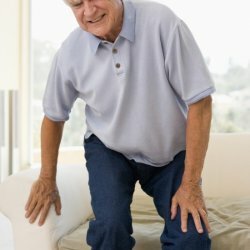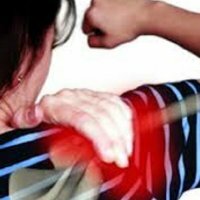Clinical manifestations of rheumatism

This is a general deterioration in the condition, sweating, fever to febrile figures( more than 38.0 degrees), lethargic - that is, the so-called phenomenon of intoxication. In a number of cases, the worsening of the condition may not be so pronounced, and the general symptomatology is erased.
Rheumatic polyarthritis
Simultaneously with the general inflammatory symptoms joint damage develops, which manifests itself in the form of short-term pains( arthralgia) and inflammation of the joints( polyarthritis).
Rheumatic polyarthritis is one of the main clinical manifestations and diagnostic criteria of mainly primary rheumatism, less often recurrent, in which arthralgia is more common.
In rheumatic polyarthritis, mainly medium and large joints are affected: knees, ankles, elbows, shoulder and, rarely, wrist bands. The nature of migraine pains, it is not for nothing that such pains are called "volatile".Symptoms of joint damage are quickly docked under the influence of anti-inflammatory therapy. In 10-15% of patients with the first attack of rheumatism, signs of polyarthritis may be absent.
The severity of polyarthritis can be different - from severe pains with swelling and reddening of the skin to a barely noticeable change in the contours of the joint with a thorough examination.
Most often rheumatic polyarthritis passes without a trace. However, with frequent recurrence, it is extremely rare, in patients with heart disease, chronic post-inflammatory arthritis of Jacques can develop, in which small joints of the hands and feet are affected.
Already in the acute period of the disease in 80-85% of patients revealed signs of heart damage. This is the main criterion for diagnosing rheumatism.
Carditis
Cardiac damage - carditis - is central to the rheumatism clinic. It can flow as a myocardium - a defeat of the heart muscle;Endocarditis - defeat of the valvular apparatus of the heart;Pericarditis - defeat of the heart bag;Or pancarditis - involvement in the pathological process of all the membranes of the heart. The most common manifestation of heart damage is endomyocarditis.
When the heart is damaged, the patient's condition worsens: paleness, fatigue, quickening or decreasing heart rate, in severe cases - signs of cardiovascular insufficiency( swelling, dyspnea), heart rhythm disturbances. When examined, the patient is determined to expand the boundaries of the heart, with auscultation( listening), the deafness of the heart sounds, the appearance of noise.
More than half of patients during the first attack show signs of damage to the valvular apparatus of the heart. As a result of inflammation in the valves, ulceration occurs, followed by the formation of thrombi in the place of ulcers and further scarring. This leads to deformation of the valve and the formation of heart disease. Most often, the mitral valve is affected, then the aortic valve and, last but not least, the tricuspid valve. Deficient mitral valve insufficiency, mitral stenosis and combined defects with a predominance of insufficiency or stenosis;In the end, the process ends in stenosis. The mitral orifice during stenosis can be 2-14 times less than normal.
The occurrence of heart defects leads to a violation of the blood flow velocity, which in turn against the background of the current endocarditis can lead to the development of fibrinous "growths" at the site of the valve lesion. When they are separated, they are carried with blood flow through the aorta along the vascular bed, forming blood clots in the arteries. If there is a clotting of the blood clot of the brain, the patient has a stroke;With lesions of the intestinal vessels - thrombembolia of the mesenteric arteries.
The myocardium also develops a sclerotic process, and if a cardiac conduction system is involved in the sclerosis zone, the patient may develop an arrhythmia.
Electrocardiography is performed to diagnose the functional state of the cervical muscle and to determine the heart defects, reflecting the state of metabolic processes in the myocardium and cardiac rhythm disturbances, as well as phonocardiography and echocardiography, which allow to study the degree of involvement of the heart valves in the rheumatic process and the character of the heart defect.
Rheumatic vasculitis
Simultaneously with the defeat of the heart, there is a lesion of the blood vessels - rheumatic vasculitis. The capillaries are most often affected, but in severe cases large vessels, including the aorta, may suffer. Rheumatic vasculitis determines the following clinical manifestations of rheumatism.
-
Kidney damage is noted in 50% of cases. At the same time, depending on the caliber of the affected vessel( renal artery branches or, for example, glomerular capillaries), the degree of kidney damage can be different - from short-term toxic jade to glomerulonephritis. In urinalysis, leukocytes, erythrocytes, and proteins are determined.
-
Liver damage is noted in 5-7% of patients, as a rule, is of a non-severe nature.
-
Rheumatic pulmonary disease, including rheumatic pneumonia;Develops due to vasculitis in the pulmonary artery system. It occurs in 2-5% of cases, most often in children with acute or continuously recurrent course of rheumatism against the background of severe carditis. In rheumatic pneumonia, the patient has increased dyspnea, an increase in body temperature;When listening to the lungs, wet, different-sized wheezing is determined. With the defeat of small capillaries of the lungs can be hemoptysis.
-
Skin lesion in rheumatism is most often manifested by ring-shaped erythema and rheumatic nodules and belongs to the main diagnostic criteria of the disease. In recent years, skin damage is less common. Ring-shaped erythema - a pale pink, almost invisible rashes in the form of a thin ring-shaped rim with a clear outer contour. Rashes can merge, they are located on the shoulders and trunk, less often on the legs, neck, face. They are not accompanied by itching or pain and disappear rather quickly. Rheumatic nodules are dense, slow-moving, painless formations ranging in size from millet grain to beans, located in the subcutaneous tissue more often on the outer( extensor) surfaces of the joints - elbows, knees, joints of the fingers, ankles, and spinous processes of the vertebrae. Rheumatic nodules undergo reverse development within 1-2 months.
-
The lesions of the nervous system caused by vasculitis of cerebral vessels are extremely diverse. Most often it is manifested by emotional instability, increased excitability, depression, fatigue, as well as vasomotor instability and increased sweating. Less common are the classic forms of central nervous system( CNS) damage - meningitis, encephalitis or rheumatic chorea, characterized by the appearance of involuntary movements( hyperkinesis) of varying severity.
-
Rheumatic chorea is also the main diagnostic criterion of rheumatism. Small chorea is more common in children and adolescents, usually in girls and in pregnant women who have fallen ill with rheumatism. At the same time the patient's mental state changes: he becomes emotionally unstable, selfish, capricious, absent-mindedness, fatigue, and aggressiveness may appear. There is a motor anxiety - hyperkinesia, which are manifested by grimacing, inattention of speech, involuntary disorderly movements. The patient does not hold the spoon badly during meals, his handwriting changes. Rheumatic chorea is also accompanied by increasing muscle weakness, when gait is disturbed, in severe cases the patient can not sit, swallow and combine other simple movements. At the same time, the symptoms of "flabby shoulders" appear when, when lifting the patient over the armpits, the head plunges deeply into the shoulders, "the symptoms of Filatov's eyes and tongue" - the inability to simultaneously close your eyes and stick out your tongue. All these manifestations increase during excitement and exercise and decrease during sleep.
-
The defeat of the organ of vision is manifested by rheumatic iridocyclitis, its course is protracted.
-
The defeat of serous membranes is noted in severe rheumatism and is manifested by peritonitis, pleurisy - the so-called rheumatic polyserositis develops. Rheumatic pleurisy is one of the most frequent manifestations of rheumatic polyserositis. It often occurs at the very beginning of the disease, along with arthralgia. Complaints of the patient on pain during breathing, as well as listening to "noise of friction of the pleura" make one think about this complication. Pleurisy with a lot of effusion is noted in our time rarely, mainly in children with a rapid course of rheumatism. As a rule, all these changes undergo rapid reverse development under the influence of anti-inflammatory therapy.
In childhood, with a rapid flow of rheumatism, there is also an abdominal syndrome-the sudden appearance of spilled or localized abdominal pain, nausea, sometimes vomiting, there may be stool retention or, conversely, diarrhea. The pains are variable in nature both in intensity and in localization. There is soreness in palpation and a slight tension in the anterior abdominal wall, because the underlying abdominal syndrome is rheumatic peritonitis. Abdominal pain, as a rule, is combined with polyarthritis and other symptoms and quickly disappears after the onset of anti-inflammatory therapy.
Clinical manifestations of recurrence of rheumatism depend on the activity of the pathological process and the changes that the patient had as a result of previous attacks, primarily from the heart. Each subsequent attack, as a rule, proceeds with the same symptoms as the previous one, but the heart is still playing the leading role. After the transfer of several attacks in the patient, as a rule, almost all of the occurring acquired heart defects are formed.
Be Healthy!



